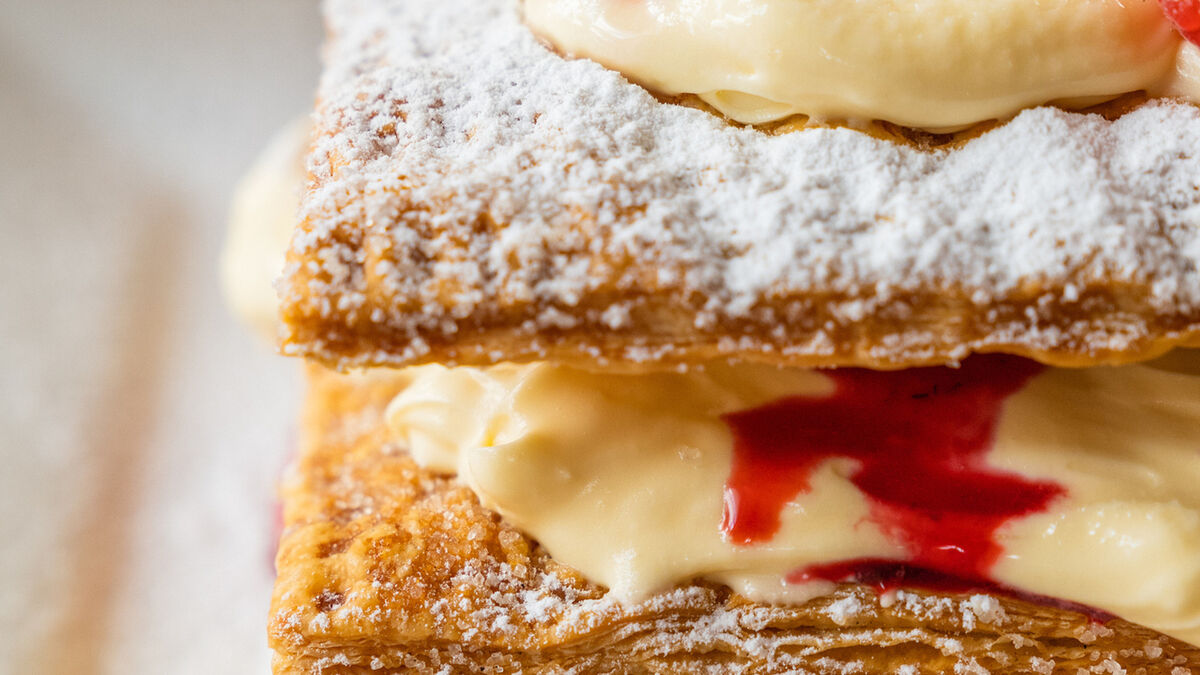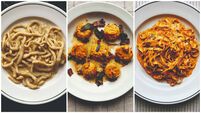Michelle Darmody: How to bake the perfect crisp but squishy custard slice

You can make one large slice and very methodically cut this into squares if you like a really clean lined finish. This is how most French pâtissiers would make their custard slices.
The perfect custard slice is sweet, squishy, and squelchy on the inside, and crisp and brittle on the outside.
Custard Slices
The combination of a set custard and crisp pastry appears in many different cultures.

Servings
6Preparation Time
25 minsCooking Time
30 minsTotal Time
55 minsCourse
BakingIngredients
300g puff pastry sheets
500 ml milk
1 tsp vanilla
100g golden caster sugar
4 egg yolks
40g cornflour
40g butter
150g raspberries
1 tbsp Grand Marnier
Method
Line a large flat baking tray with parchment.
Preheat your oven to 200ºC/gas mark 6.
Roll the sheets of puff pastry until they are 2.5 mm in thickness.
Cut out 16 rectangles and place them on the baking tray.
Place the tray into the oven to bake for 15 minutes.
Remove it gently and lay a second sheet of parchment over the pastry rectangles. Place a second baking tray on top and weigh it down. I use two heavy cast-iron dishes.
Bake for another 15 minutes until the rectangles are golden in colour.
Remove from the oven and take off the weights. Once they are cool enough to handle, move the slices onto a wire rack to cool completely.
While your pastry is baking add the milk and vanilla to a heavy-based saucepan, bring to the boil then remove from the heat.
In a bowl, whisk together the sugar, egg yolks and cornflour.
Pour a little of the hot milk into the egg and sugar mixture, whisking continuously.
Whisk in the rest of the hot milk until combined, then return to the saucepan.
Cook the mixture over a gentle heat, stirring continuously, until the mixture becomes thick and just about comes to a boil.
Remove from the heat and pass the mixture through a sieve into a clean bowl.
Add the butter and stir until melted and thoroughly combined.
Leave to cool completely in the fridge.
Mash the raspberries with the Grand Marnier liquor and set aside.
To assemble the slices, place six of the rectangles onto a large plate. Pipe or scoop the set custard onto the pastry and add a spoonful of the raspberry mixture.
Top each one with the other pastry rectangle.
Serve with the remaining raspberry mixture and dust with icing sugar if you wish.
Ready-rolled sheets of puff pastry will still need a little more rolling as they tend to be too thick for this recipe.
You can use 500g of pastry and add a middle layer to your slice if you prefer this ratio. This will also add more structure.
You compress the pastry between the baking sheets while baking to limit its expansion and rise. Compressing halfway through baking allows the pastry to bake on its own for a while. I find this gives a better result than compressing from the beginning
I tend to bake the pastry a little darker for this recipe than I would usually bake puff pastry. It adds crispness. One downside, however, is that crispy well-baked pastry is trickier to handle. Care is needed.
As crème pâtissière heats, the starch granules absorb liquid and swell, thickening the mixture. This process is called starch gelatinisation. The amount of starch in a recipe will define the thickness of the final custard.
If you have a vanilla pod, it will add greater richness than vanilla essence or extract. If using, cut the pod down the centre lengthwise and scrape the seeds into the milk. You can also add the pod to the milk as you boil it. Remove the pod before adding the milk to the egg and sugar mixture.
Keep an eye on the heat when cooking the custard. If the heat is too low it will not thicken enough but if it is too high, you may end up with scrambled eggs. It is best to heat it steadily over a low heat in a heavy-based saucepan.
If you notice lumps beginning to form in a custard, you can pour it out of the pan into a bowl and pulse it with a handheld blender in five-second intervals until it is smooth.
The custard will keep, covered, in the fridge for up to 48 hours and then you can assemble the slice when needed. The pastry can become a soggy, so the slices are best eaten when they are made, when still crisp.
You can make one large slice and very methodically cut this into squares if you like a really clean lined finish. This is how most French pâtissiers would make their custard slices. If doing it this way, be sure to use a very sharp knife and dip the knife in hot water and wipe it between cuts. Saw through the pastry so the custard doesn’t squash out the sides.





